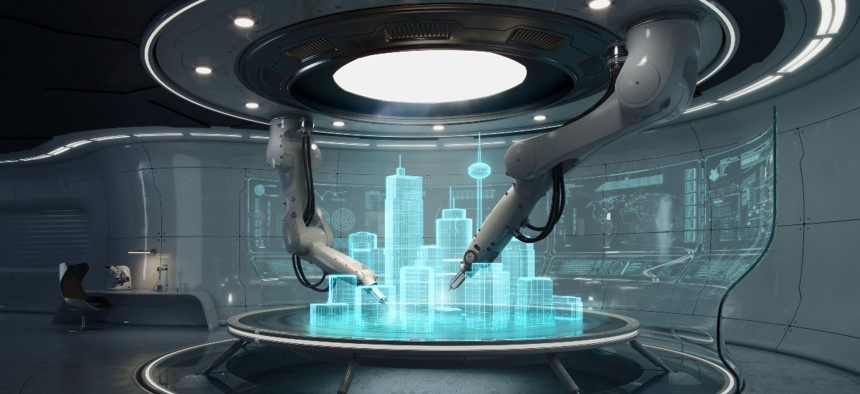How Government Might Work Up to 3D-Printed Buildings

Viaframe/Getty Images
With some emerging technologies—like large-scale 3D printing and augmented reality—agencies may have to start smaller, according to panelists at a recent conference.
Government buildings could one day be 3D printed, according to Beth Killoran, deputy chief information officer at the General Services Administration, who spoke on a panel at the Imagine Nation ELC Conference on Monday.
“They’re 3D-printing houses,” Killoran said. “We have the Public Building Service, why aren’t we 3D-printing buildings that are better for [the] environment? But we have to start with smaller than that. That’s a little bit of a step too far, that’s a change that they’re not ready for.”
While the end goal may be to eventually have 3D-printed buildings, the agency must start smaller. For example, national historical buildings have parts like lights, fixtures and crown moldings that cannot be replaced with standard, modern options. While the government has traditionally turned to industry for a solution, Killoran stated that this is something government can do itself.
“They actually take laser printing of those, and they send it out to manufacturers to build them,” Killoran said. “[It] takes a long time, takes a lot of investment. Why don’t we just scan it, put it into our 3D printer and print it ourselves? It’s something we’re looking at. We’re trying it, we’re doing” a minimum viable product.
And GSA is not the only agency looking to start small and build outward with new technologies.
A “focus in our shop is to do a lot of pilot programs for new technologies, new capabilities and [to] do that on a regular basis on a small scale,” Michael Palmer, chief experience officer and associate CIO at the Commerce Department, said
GSA is also looking at augmented reality to advance workplace design and innovation. Such technology could also enable the Public Building Service at GSA to conduct virtual inspections, rather than sending employees in person. And the State Department has explored augmented reality to monitor the U.S.-Mexico border.
“Augmented reality is something that’s been happening very frequently in the entertainment industry and other places, where you actually would have a virtual representation of you interacting with alive people and vice versa,” Killoran said. “That hasn’t happened in government, so we started thinking about how does that happen?”
Starting small can also help with user buy-in, according to Killoran.
“You have to make sure that the community by which you’re building the technology can accept it,” she said. “If you’re building a thing they don’t want, they’re gonna reject it. If you’re building it too quickly, they’re going to reject it. … They will be there, how will I bring it to them? What’s that velocity? You’re only going to know that by having the relationship with your customers and with the business.”
Despite slow implementation, Kenyon Wells, senior vice president of consulting and technology practice at CGI Federal, noted that at times the government is even ahead of industry in terms of technology.
“Classic rumor is that the government is behind technologically,” Wells said. “What I tend to find is: each agency tends to be ahead in one particular area—and may lag behind industry in certain areas, especially around business systems and efficiency in certain back office operations—but the story that government is always behind is absolutely wrong.”






